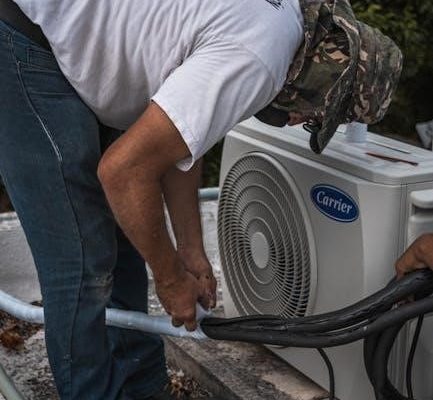The Keystone Air Conditioner Manual is a comprehensive guide designed to help users understand and optimize their unit’s features, operation, and maintenance for efficient cooling.
Overview of the Keystone Air Conditioner Manual
The Keystone Air Conditioner Manual is a detailed guide providing essential information for proper installation, operation, and maintenance of Keystone air conditioners. It covers technical specifications, safety precautions, and troubleshooting tips to ensure optimal performance. The manual includes step-by-step instructions for various models, highlighting features like cooling modes, remote control functionality, and energy-saving settings. Additionally, it emphasizes the importance of regular maintenance, such as cleaning air filters and scheduling professional servicing. This comprehensive resource helps users maximize efficiency, reduce energy costs, and extend the lifespan of their air conditioner.

Importance of Reading the Manual
Reading the Keystone Air Conditioner Manual is crucial for understanding proper installation, operation, and maintenance procedures. It ensures safety by outlining precautions to avoid injuries and damage. The manual provides troubleshooting tips to diagnose and resolve common issues, saving time and money. By following the guidelines, users can optimize energy efficiency and extend the unit’s lifespan. Regular maintenance instructions, like cleaning filters, are emphasized to maintain air quality and performance. Familiarizing yourself with the manual ensures smooth operation and maximizes the benefits of your Keystone air conditioner.

Key Components of the Keystone Air Conditioner
The Keystone Air Conditioner comprises essential components like the compressor, fan motor, condenser coils, and evaporator. These parts work together to ensure efficient cooling and airflow management.
Understanding the Parts and Functions
The Keystone air conditioner consists of several key parts, each serving a specific role. The compressor compresses refrigerant, while the condenser and evaporator coils facilitate heat exchange. The fan motor circulates air through the unit, ensuring efficient cooling. Filters are crucial for air quality, capturing dust and allergens. The thermostat and control panel regulate temperature settings. Proper functioning of each component ensures optimal performance and energy efficiency. Regular maintenance, such as cleaning filters and checking coils, is essential for extending the unit’s lifespan and maintaining its operational efficiency.
Different Models and Their Features
Keystone offers a variety of air conditioner models, each designed to meet specific needs. The KSTHW series is known for high efficiency and advanced features, while the KSHN series provides reliable performance at a budget-friendly price; The KSLS series is compact and ideal for small spaces. Some models feature smart technology, allowing Wi-Fi control via a smartphone app. Energy Star-certified units like the KSTHP series offer superior energy savings. Each model varies in BTU capacity, noise levels, and additional features like Sleep Mode or Turbo Mode for enhanced comfort.

Installation Instructions
Proper installation ensures optimal performance. Follow guidelines for location selection, leveling, and securing the unit. Use appropriate tools and ensure safety measures are in place;
Pre-Installation Preparation
Before installing your Keystone air conditioner, ensure the installation site is level and clear of obstacles. Verify electrical requirements match your unit’s specifications. Gather necessary tools like a screwdriver, pliers, and a measuring tape. Read the manual thoroughly to understand specific installation needs. Check for any damage or missing parts in the packaging. Plan for proper drainage to prevent water leakage. Ensure the area is well-ventilated and suitable for the unit’s size. Safety precautions, like disconnecting power before starting, are crucial. Proper preparation ensures a smooth and safe installation process.
Step-by-Step Installation Guide
Begin by unpacking the air conditioner and ensuring all components are included. Position the unit on a level surface, aligning it with the recommended installation area. Secure the unit using the provided mounting hardware. Connect the electrical wires according to the manual’s wiring diagram. Attach the drain hose to the designated outlet to prevent water accumulation. Install any additional features like a drain pan or support bracket. Turn on the power and test the unit by setting the thermostat to a lower temperature. Ensure all connections are tight and the system operates smoothly; Follow all safety guidelines during installation.
Common Installation Mistakes to Avoid
Avoid common installation mistakes to ensure your Keystone air conditioner operates efficiently. Ensure the unit is placed on a level surface to prevent drainage issues and vibration. Double-check all electrical connections to prevent power supply problems. Do not overlook the installation of a drain pan to avoid water damage. Secure the unit firmly to prevent movement during operation. Ensure the air filter is properly installed to maintain airflow. Avoid obstructing the unit’s vents for optimal performance. Regularly inspect and clean the condenser coils to prevent reduced efficiency. Always follow the manufacturer’s guidelines for installation and maintenance.

Operating the Keystone Air Conditioner
Power on the unit using the control panel or remote. Adjust temperature, mode, and fan speed as needed. Regularly clean filters and check drainage for optimal performance.
Understanding the Control Panel
The control panel is the central hub for operating your Keystone air conditioner. It features buttons for mode selection (Cool, Heat, Fan), temperature adjustment, and fan speed control. The display screen shows the current settings, while the power button turns the unit on/off. Use the up and down arrows to set your desired temperature. The mode button lets you switch between cooling, heating, or fan-only operation. Familiarize yourself with these controls to customize your comfort experience effectively.
Using the Remote Control Effectively
The remote control allows you to conveniently operate your Keystone air conditioner from a distance. It features buttons for power on/off, mode selection (Cool, Heat, Fan), temperature adjustment, and fan speed control. Use the “Mode” button to switch between cooling, heating, or fan-only operation. The “Up” and “Down” arrows adjust the temperature, while the “Fan” button sets the airflow speed. Ensure the remote is aimed directly at the unit’s control panel for proper signal reception. Replace batteries promptly when the remote’s performance diminishes. Regularly check the LCD display for accurate settings and use the timer function to optimize energy usage.
Exploring Cool, Heat, and Fan Modes
Your Keystone air conditioner offers three primary operating modes: Cool, Heat, and Fan. The Cool mode cools the room by circulating refrigerated air, while Heat mode warms it using the heating element. Fan mode circulates air without cooling or heating, ensuring consistent airflow. Use the remote or control panel to switch modes. For optimal comfort, adjust the temperature and fan speed accordingly. Cool mode is ideal for hot days, Heat mode for colder conditions, and Fan mode for maintaining air circulation. Always refer to your manual for mode-specific features and settings.
Navigating the Timer and Sleep Functions
The Keystone air conditioner features a timer and sleep function to enhance convenience and energy efficiency. The timer allows you to set specific start and stop times, ensuring your unit operates only when needed. The sleep function automatically adjusts temperature settings during sleep, preventing extreme temperatures and saving energy. Use the remote or control panel to activate these modes. Set the timer for up to 24 hours in advance and customize the sleep mode duration for optimal comfort. These features help reduce energy consumption without compromising performance or comfort.
How to Clean the Air Filters
Cleaning the air filters is essential for maintaining your Keystone air conditioner’s efficiency and performance. Turn off the unit before cleaning to avoid damage or dust dispersal. Locate the filters, usually found behind the front panel or in the return air vent. Gently remove them and vacuum with a soft-bristle brush or rinse with warm water. Avoid using harsh chemicals or scrubbers that may damage the filter material. Allow the filters to dry completely before reinstalling. Clean the filters every 1-2 months or as needed to ensure optimal airflow and air quality.
Scheduling Regular Maintenance
Regular maintenance is crucial to ensure your Keystone air conditioner operates efficiently and lasts longer. Create a maintenance schedule to inspect and clean filters every 2-3 months, and check condenser coils annually. Inspect drain lines for blockages and ensure proper drainage. Schedule professional servicing at least once a year to address hidden issues. Regular maintenance prevents breakdowns, reduces energy bills, and keeps your system running at peak performance. Always follow the manufacturer’s recommendations for timing and procedures to maintain warranty validity and ensure optimal functionality.

Drainage and Water Leakage Prevention
Proper drainage is essential to prevent water leakage in your Keystone air conditioner. Regularly inspect the drain pan and pipes for blockages or damage. Clean the drain line with a vacuum or water pressure to ensure smooth water flow. Ensure the unit is installed on a level surface to prevent water from pooling. Check the drain hose for kinks or bends that could restrict flow. If you notice water leakage, turn off the unit immediately and address the issue. Regular maintenance can prevent costly repairs and ensure efficient operation. Always follow the manual’s guidance for drainage system care.

Troubleshooting Common Issues
Troubleshooting your Keystone air conditioner involves identifying issues like cooling problems or error codes. Always check power supply, filters, and settings. Consult the manual’s troubleshooting section for solutions and contact support if issues persist. Regular checks can prevent major malfunctions, ensuring optimal performance and comfort; Always follow the manual’s guidance for quick and effective issue resolution. Proper troubleshooting can extend the unit’s lifespan and efficiency, while also saving time and money on repairs. Keep the manual handy for easy reference. Ensure all steps are followed carefully for best results.
Identifying and Solving Operational Problems
Identifying operational issues with your Keystone air conditioner starts with observing unusual behaviors, such as strange noises, reduced cooling, or incomplete cycles. Begin by checking the power supply, ensuring the unit is properly plugged in and circuit breakers are not tripped. Verify thermostat settings to ensure they are correctly programmed. Clean or replace air filters if they are dirty, as this can restrict airflow and reduce efficiency. For more complex issues, like refrigerant leaks or compressor failures, consult the manual’s troubleshooting guide or contact a professional. Regular maintenance and timely repairs can prevent minor problems from escalating. Always refer to the manual for specific solutions tailored to your model. If issues persist, reaching out to Keystone’s customer support is recommended for assistance. Proper troubleshooting ensures your air conditioner runs smoothly and efficiently, maintaining comfort and extending its lifespan. Regular checks and prompt action are key to resolving operational problems effectively.
Handling Error Codes and Alarms
Keystone air conditioners display error codes to indicate specific issues. These codes, such as E1, E2, or E3, are designed to help diagnose problems quickly. Refer to the manual’s error code section to understand their meanings. For example, E1 often relates to sensor malfunctions, while E2 may indicate communication issues between indoor and outdoor units. To resolve these, restart the unit, check sensor connections, or ensure proper installation. If the issue persists, contact a certified technician. Always unplug the unit before performing any manual checks to ensure safety. Regularly updating your manual ensures access to the latest error code explanations and solutions. Timely addressing these alerts prevents further damage and ensures optimal performance. Keep the manual handy for quick reference when error codes appear, as they are essential for maintaining your air conditioner’s efficiency and longevity. Prompt action guarantees uninterrupted comfort and extends the unit’s lifespan. Always prioritize resolving error codes to avoid costly repairs.
Safety Guidelines
Always unplug the unit before maintenance to avoid electric shock. Ensure proper installation and ventilation to prevent gas leaks or fire hazards. Keep flammable materials away and avoid exposing the unit to extreme temperatures. Regularly inspect power cords and plugs for damage. Follow all safety precautions outlined in the manual to ensure safe operation and prevent accidents. Never attempt repairs without proper training or tools. Always prioritize safety to protect yourself and maintain the unit’s efficiency. Adhere to manufacturer guidelines for installation, usage, and maintenance to avoid potential risks. Keep children and pets away from moving parts and electrical components. Never operate the air conditioner near water or in humid environments without proper grounding. Ensure the unit is installed on a level surface to prevent tipping or instability. Avoid overheating by maintaining adequate airflow around the unit. Never modify or tamper with safety features, as this can lead to serious hazards. Always follow local safety regulations and standards for air conditioner installation and use. Keep emergency contact information handy in case of accidents or malfunctions. Never ignore warning signs like unusual noises, leaks, or burning smells. Always turn off the unit during thunderstorms or power outages to prevent damage or electrical shock. Regularly clean and maintain the unit to prevent mold growth and ensure healthy air quality. Never use the air conditioner as a drying rack for clothes or other items, as this can cause damage or fire. Always store the remote control out of reach of children to avoid accidental operation. Never use the air conditioner in areas with open flames or sparks, as this can ignite flammable gases. Always ensure the unit is properly grounded to prevent electrical shocks. Keep the air conditioner away from direct sunlight to avoid overheating and reduced efficiency. Never operate the unit with damaged or worn-out parts, as this can lead to safety hazards. Always follow the manufacturer’s instructions for resetting the unit after a power outage. Keep the manual handy for quick reference in case of emergencies or safety concerns. Always prioritize safety when operating, maintaining, or repairing the air conditioner to protect yourself and others. Regular inspections and maintenance can help identify potential safety issues before they become serious problems. Never attempt to fix the unit while it is running or plugged in, as this can result in injury or death. Always use genuine replacement parts to ensure compatibility and safety. Keep the area around the air conditioner clean and clear of debris to prevent fires or other hazards. Never install the unit near combustible materials or in enclosed spaces without proper ventilation. Always follow the recommended weight limits and installation guidelines to prevent unit instability. Regularly check for updates or recalls on your air conditioner model to ensure compliance with safety standards. Never use the air conditioner in areas with poor ventilation, as this can lead to carbon monoxide buildup or other hazards. Always ensure the unit is installed by a qualified technician to meet safety and efficiency standards. Keep the air conditioner away from children’s play areas to prevent accidental damage or injury. Never ignore safety warnings or precautions provided in the manual, as they are designed to protect you and ensure safe operation. Always be aware of your surroundings when operating the air conditioner to prevent accidents or injuries. Regular safety checks can help maintain the unit’s performance and extend its lifespan. Never use the air conditioner as a substitute for proper ventilation in areas with hazardous fumes or chemicals. Always follow the manufacturer’s guidelines for cleaning and maintaining the unit to prevent mold, mildew, and bacteria growth. Keep the air conditioner away from pets to avoid damage or accidental operation. Never operate the unit in areas with high humidity without proper drainage to prevent water damage or electrical issues. Always ensure the unit is properly secured during transportation to avoid damage or safety risks. Regularly inspect the unit’s electrical components to prevent short circuits or other hazards. Never use the air conditioner near swimming pools or hot tubs without proper installation and safety precautions. Always follow the recommended usage guidelines to avoid overloading the unit and causing safety issues. Keep the air conditioner away from direct contact with water or moisture to prevent electrical shock or damage. Never ignore unusual odors, noises, or vibrations, as they can indicate potential safety hazards. Always ensure the unit is installed on a stable and level surface to prevent tipping or instability. Regularly check the unit’s drainage system to prevent water leakage or mold growth. Never attempt to repair the unit while standing on an unstable surface or ladder, as this can lead to falls or injuries. Always follow the manufacturer’s instructions for resetting the unit after a power outage to ensure safe operation. Keep the air conditioner away from areas with high traffic to prevent accidental damage or disruption. Never use the unit in areas with poor air circulation, as this can lead to reduced efficiency and safety risks. Always ensure the unit is properly ventilated to prevent the buildup of harmful gases or fumes. Regular inspections and maintenance can help identify potential safety issues before they become serious problems. Never use the air conditioner in areas with open flames or sparks, as this can ignite flammable gases. Always ensure the unit is properly grounded to prevent electrical shocks. Keep the air conditioner away from direct sunlight to avoid overheating and reduced efficiency. Never use the air conditioner as a drying rack for clothes or other items, as this can cause damage or fire. Always store the remote control out of reach of children to avoid accidental operation. Never use the air conditioner in areas with combustible materials without proper installation and safety precautions. Always follow the manufacturer’s instructions for resetting the unit after a power outage to ensure safe operation. Keep the manual handy for quick reference in case of emergencies or safety concerns. Always prioritize safety when operating, maintaining, or repairing the air conditioner to protect yourself and others. Regular inspections and maintenance can help identify potential safety issues before they become serious problems. Never attempt to fix the unit while it is running or plugged in, as this can result in injury or death. Always use genuine replacement parts to ensure compatibility and safety. Keep the area around the air conditioner clean and clear of debris to prevent fires or other hazards. Never install the unit near combustible materials or in enclosed spaces without proper ventilation. Always follow the recommended weight limits and installation guidelines to prevent unit instability. Regularly check for updates or recalls on your air conditioner model to ensure compliance with safety standards. Never use the air conditioner in areas with poor ventilation, as this can lead to carbon monoxide buildup or other hazards. Always ensure the unit is installed by a qualified technician to meet safety and efficiency standards. Keep the air conditioner away from children’s play areas to prevent accidental damage or injury. Never ignore safety warnings or precautions provided in the manual, as they are designed to protect you and ensure safe operation. Always be aware of your surroundings when operating the air conditioner to prevent accidents or injuries. Regular safety checks can help maintain the unit’s performance and extend its lifespan. Never use the air conditioner as a substitute for proper ventilation in areas with hazardous fumes or chemicals. Always follow the manufacturer’s guidelines for cleaning and maintaining the unit to prevent mold, mildew, and bacteria growth. Keep the air conditioner away from pets to avoid damage or accidental operation. Never operate the unit in areas with high humidity without proper drainage to prevent water damage or electrical issues. Always ensure the unit is properly secured during transportation to avoid damage or safety risks. Regularly inspect the unit’s electrical components to prevent short circuits or other hazards. Never use the air conditioner near swimming pools or hot tubs without proper installation and safety precautions. Always follow the recommended usage guidelines to avoid overloading the unit and causing safety issues. Keep the air conditioner away from direct contact with water or moisture to prevent electrical shock or damage. Never ignore unusual odors, noises, or vibrations, as they can indicate potential safety hazards. Always ensure the unit is installed on a stable and level surface to prevent tipping or instability. Regularly check the unit’s drainage system to prevent water leakage or mold growth. Never attempt to repair the unit while standing on an unstable surface or ladder, as this can lead to falls or injuries. Always follow the manufacturer’s instructions for resetting the unit after a power outage to ensure safe operation. Keep the air conditioner away from areas with high traffic to prevent accidental damage or disruption. Never use the unit in areas with poor air circulation, as this can lead to reduced efficiency and safety risks. Always ensure the unit is properly ventilated to prevent the buildup of harmful gases or fumes. Regular inspections and maintenance can help identify potential safety issues before they become serious problems. Never use the air conditioner in areas with open flames or sparks, as this can ignite flammable gases. Always ensure the unit is properly grounded to
Precautions for Safe Operation
Always ensure the air conditioner is installed and operated as per the manual to avoid accidents. Never use the unit near water or in humid environments without proper grounding. Keep the appliance away from direct sunlight, flammable materials, and extreme temperatures. Avoid operating the air conditioner in areas with poor ventilation or near open flames. Regularly inspect and clean filters to prevent fire hazards. Do not touch electrical components with wet hands or while standing on a wet surface. Ensure the unit is placed on a stable, level surface to prevent tipping. Keep children and pets away from moving parts and electrical components. Never modify the unit or bypass safety features. Always use a grounded power outlet to prevent electrical shock. Do not operate the air conditioner during thunderstorms or power outages. Ensure proper drainage to avoid water accumulation, which can lead to mold or electrical issues. Always follow the manufacturer’s guidelines for safe operation and maintenance. Regularly check for worn-out parts and replace them promptly. Avoid using the air conditioner in areas with corrosive substances or high levels of dust, as this can damage the unit. Never attempt to repair the unit while it is running or plugged in. Always unplug the air conditioner before performing any maintenance or cleaning. Ensure the remote control is stored safely to prevent accidental operation. Do not use the air conditioner as a drying rack for clothes or other items, as this can cause damage or fire. Always follow local safety regulations and guidelines for air conditioner usage. Keep the area around the unit clean and clear of debris to ensure proper airflow and safety. Regularly inspect the power cord and plug for signs of wear or damage. Do not overload the unit or operate it beyond its recommended capacity. Always ensure the air conditioner is installed by a qualified technician to meet safety standards. Keep the manual handy for quick reference in case of emergencies or safety concerns. Always prioritize safety when operating, maintaining, or repairing the air conditioner to protect yourself and others.
Handling and Storage Tips
Always handle the air conditioner with care to avoid damage. When moving, use the built-in handles and keep the unit upright to prevent internal components from shifting. Store the air conditioner in a dry, clean environment, away from direct sunlight and moisture. Use the original packaging or a sturdy cover to protect it from dust and scratches. Avoid stacking heavy objects on top of the unit. Ensure the storage area is well-ventilated and within the recommended temperature range. Before storing, clean the unit and ensure it is completely dry to prevent mold or rust. For long-term storage, refer to the manual for specific guidelines. Store the remote control separately in a safe, dry place. Do not store the air conditioner near flammable materials or chemicals. Regularly inspect the unit before and after storage to ensure it remains in good condition. Proper handling and storage will extend the lifespan and maintain the efficiency of your Keystone air conditioner.

Technical Specifications
The Keystone air conditioner manual outlines key technical details, including BTU ratings, energy efficiency, and operational features, ensuring optimal performance and compliance with industry standards.
BTU Ratings and Efficiency
Keystone air conditioners offer a range of BTU ratings, from 5,000 to 24,000 BTUs, catering to various room sizes and cooling needs. Properly matching the BTU rating to the space ensures efficient cooling and energy savings. The units feature high seasonal energy efficiency ratio (SEER) ratings, typically between 10 and 16, indicating superior energy efficiency. Higher SEER ratings mean lower energy consumption and reduced utility bills. Additionally, the energy efficiency ratio (EER) ensures optimal performance during peak summer temperatures, making Keystone air conditioners both eco-friendly and cost-effective for long-term use.
Power Requirements and Voltage
Keystone air conditioners are designed to operate efficiently with standard household electrical systems. Most models require 115 or 230 volts, depending on the unit’s size and cooling capacity. The power consumption ranges from 400 to 1,800 watts, ensuring compatibility with typical residential circuits. Proper installation requires matching the unit’s power requirements with your home’s electrical capacity to avoid tripped breakers or electrical issues. Always consult a licensed electrician for hard-wired models to ensure safe and correct installation, adhering to local electrical codes and safety standards.
Energy Star Ratings and Benefits
Keystone air conditioners with Energy Star certification offer superior energy efficiency, reducing your utility bills and environmental impact. These models meet strict U.S. EPA standards, ensuring optimal performance while saving energy. Energy Star-rated units often qualify for rebates and incentives, making them a cost-effective choice. By choosing an Energy Star-certified air conditioner, you contribute to energy conservation and lower greenhouse gas emissions; This eco-friendly option aligns with sustainable living practices, providing long-term savings and environmental benefits. Always look for the Energy Star logo when selecting your Keystone air conditioner for a smarter, greener cooling solution.
Eco-Friendly Refrigerants and Compliance
Keystone air conditioners utilize eco-friendly refrigerants that comply with environmental regulations, minimizing harm to the ozone layer and reducing greenhouse gas emissions. These refrigerants, such as R-32, are designed to meet global sustainability standards and are safer for the environment compared to older refrigerants. By adhering to regulations like the Clean Air Act and EPA guidelines, Keystone ensures its products align with eco-conscious practices. This commitment to environmental compliance not only supports global efforts to combat climate change but also offers customers a greener, more responsible cooling solution for their homes.

Optimizing Performance
Maximize your air conditioner’s efficiency and comfort by using features like timer settings, sleep mode, and adjusting fan speeds to match your needs effectively.
Best Practices for Energy Savings
To optimize energy efficiency, adjust your thermostat settings to balance comfort and savings. Regularly clean or replace air filters to ensure proper airflow. Use the timer function to turn off the unit when not needed, and enable sleep mode to reduce energy consumption during extended periods. Properly insulate your space to maintain consistent temperatures, and avoid overcooling. By following these practices, you can significantly lower your energy bills while keeping your environment comfortable and extending the lifespan of your air conditioner.

Warranty and Support
Adjusting Settings for Maximum Comfort
For optimal comfort, adjust the thermostat to maintain a consistent temperature, ideally between 68-72°F in winter and 70-75°F in summer. Use the remote control to conveniently regulate settings without moving from your spot. Experiment with Cool, Heat, and Fan modes to suit your needs. Activate the timer to automatically turn the unit on/off, and utilize sleep mode to maintain comfort while saving energy. Regularly check and adjust settings to ensure your space remains cozy without overworking the unit, enhancing both comfort and efficiency.



